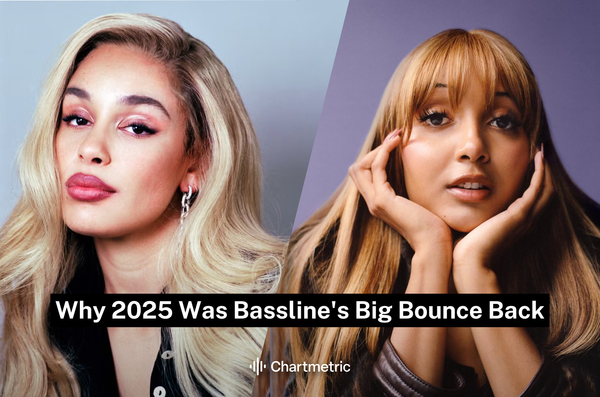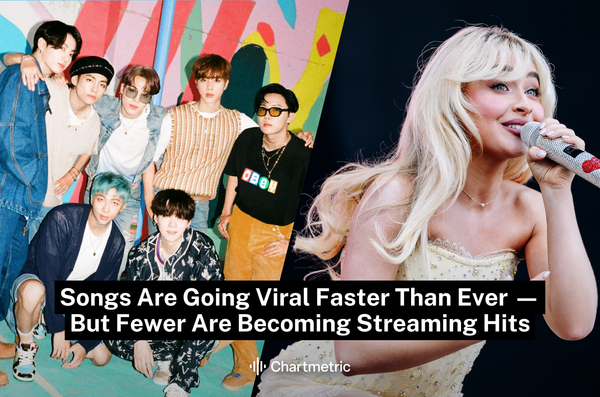Neoperreo has emerged as one of the most important reggaeton subgenres in the past seven years. A raw, DIY alternative to the mainstream, it embraces digital culture, gender fluidity, and underground club aesthetics. Characterized by distorted bass, stripped-down dembow beats and dancehall rhythms, it blends lo-fi production with electronic and club influences, often featuring boundary-pushing lyrics.
The genre gained traction in the late 2010s through SoundCloud, YouTube, and Instagram, led by LA-based artists like Argentina’s Ms Nina and Chile’s Tomasa del Real, captivating younger listeners with its hyper-digital, unapologetic style. Unlike traditional reggaeton, it prioritizes inclusivity, amplifying LGBTQ+ and feminist voices.
Its digital nature helped it spread mainly to Mexico, which today represents around 40% of both aforementioned artists' total Spotify audience, but also to Spain, Argentina, and Colombia, eventually reaching festivals like Primavera Sound and Lollapalooza.
Ms Nina’s biggest hit is the single “Tu Sicaria” released in January 2017 and has over 175 million Spotify streams. Other important tracks are “Noche de Verano” and “Los Angeles” with around 8 million Spotify streams each.
By the early 2020s, neoperreo evolved from an internet-driven alternative movement into a global force, redefining reggaeton’s typically heteronormative rules. With its gritty beats, experimental sounds, and sensual identity, neoperreo became a staple in the repertoires of several major artists, allowing women to rap freely about self-expression. This includes Rosalía (whose 2022 release “MOTOMAMI” relies heavily on neoperreo’s sound), Bad Bunny, Feid, and Karol G, among others.
Modern Champions of Neoperreo
Notwithstanding, the creative driving forces behind this evolving underground music scene are emerging female artists.
In the contemporary Latin music landscape, the artist that represents the neoperreo spirit the best is Tokischa, a Dominican singer and rapper known for her blunt, unapologetic style and genre-blending music. She fuses old-school dembow and trap with raunchy lyrics that challenge social norms. Her rebellious persona and collaborations with massive artists like Rosalía, J Balvin, and Madonna have propelled her to international recognition, making her one of the most influential and controversial voices in Latin urban music today - all without having released a full album yet.
Her streaming performance tends to rise alongside her releases, helping Tokischa cultivate a strong social media presence, particularly in the U.S. and Mexico. TikTok has played a crucial role in her success, with many of her singles quickly turning into viral trends.
@domelipa Mañana nos ponemos 🙅🏻♀️🙅🏻♀️🙅🏻♀️
♬ XXX - DOMELIPA
Furthermore, Honduran artist Isabella Lovestory has crafted her own identity as a neoperreo star. She embraces sexuality and boldly claims that "Mocking men is fun. Mocking what society views as degrading to women is fun, because nobody gets to decide what a woman's true desires are."
Isabella gained notoriety with her tracks “Mariposa” and “Golosa,” which became her fastest-growing songs since their release in 2020. More recently, her collaborations “Fuetazo” with Villano Antillano and “True Religion” with Shygirl also led to a major Spotify monthly listeners spike, growing from 159K to 751K. Additionally, Isabella saw a notable increase in her YouTube subscribers, driven by the release of the music video for “Botoxxx” and an Instagram reel of her Pitchfork “My Perfect 10” interview by mid 2024.
Neoperreo in Mexico
As mentioned, Mexico is home to one of the biggest neoperreo movements, which currently is led by Katherine Huerta, aka Bellakath, who has over 7.5 million monthly Spotify listeners. Known for her late 90’s/early 00’s reggaeton beats and viral TikTok verses, she recently signed with Warner Music Mexico and utilizes social media for sharing music, performances, personal moments, and dance choreographies from her songs, growing her fanbase to a total of 15.2 million followers.
Her biggest tracks are “Vaquero” remix (a 2005 song by La Dinastía that has become viral again thanks to Bellakath’s verse becoming popular in TikTok dances), “Reggaeton Champagne”, “Gatita” and “Y Yo Me Le Pego” with hundreds of thousands of Spotify streams.
@leaelui Twins 👯♀️💕 @Lola Lolita🌸
♬ VAQUERO REMIX Bellakath - BELLAKATH 👸🏻
Niche Mexican singer EMJAY is also building steam within neoperreo with an ambitious hyperpop approach. Though there have been rumors of a rivalry with Bellakath, her versatility and creativity have kept fans focused on her distinctive artistry.
Tracks like “La Maña”, “boss” and “UZI”, showcase her ability to merge many genres, taking neoperreo to a forward-looking stage, featuring groundbreaking rapping and clubbing elements.
Argentina, Chile, and Spain
In Argentina, Joaquinha Lerena, aka La Joaqui or "Tu Patrona," combines neoperreo, cumbia villera, reggaeton, and hip hop. Originally making her mark as a novice freestyle rapper in battles at El Quinto Escalón (where artists like Bizarrap, Duki, and Nicki Nicole broke through), she later transitioned to music professionally. Known for her bold personality and empowering messages, La Joaqui reflects on personal struggles and resilience, becoming a key figure in Argentina's urban music scene.
Similarly to Bellakath, La Joaqui has a knack for memorable hooks and verses that spark virality on TikTok, inspiring popular dance trends among influencers.
Chile is also demonstrating to also have one of the most vibrant Latin urban music outputs in recent years. Akriila is, perhaps, the most groundbreaking and pioneering neoperreo artist to come from this scene, elevating urban music to the next level. Born Fernanda Sepúlveda, Akriila uses dreamy synths with haunting vocals, creating immersive experiences of ethereal and deconstructed electronic soundscapes that delve into themes of introspection, identity, and emotional depth.
Her talent has caused her music to grow organically, ultimately landing in the top 5 neoperreo artists in Chile according to Chartmetric rank. Nevertheless, she still needs to break internationally, as her Spotify audience remains around 88% Chilean.
Across the pond in Spain, female singers are embracing the confidence and self-expression of neoperreo, leveraging influence from Latin American music.
Bad Gyal, born Alba Farelo, embodies the sensual and clubbing aesthetic of neoperreo combining dancehall, reggaeton, trap and electronic music. Her sound has been boosted by collaborations with top producers like El Guincho, Fakeguido, and Florentino, giving her a futuristic and club-ready edge. Her recent album released in 2024, La Joia has attested to her relevance in urban Spanish music, driven by leading single “Chulo pt.2” with Tokischa and Young Miko, which amassed almost 400 million Spotify streams to date.
Spain’s trap queen, La Zowi (Zoe Jeanneau Canto), originated from the vibrant Spanish trap movement, evolving her sound into dark, hypnotic, and heavily autotuned tracks. This icy, bad-girl aesthetic distinguishes her from popular reggaeton. Hits like "Sugar Mami," "Yo Tengo Un Novio" with Lola Indigo, and "Ping Pong" are neoperreo staples with tens of millions of Spotify streams.
More recently, Belize Nicolau Kazi, best known as Bb trickz, released a number of successful Latin urban songs which adopted a drill-influenced sound. Her music, attitude, and aesthetic embody the irreverence of neoperreo, infused with a playful and humorous tone that shines through her talent for social media and meme culture—making her go viral at every turn. With that in mind, it’s no surprise that Instagram accounts for 63% of BB Trickz's total audience across all platforms.
Bb Trickz first gained mainstream success with “Soy La Mas Mala,” a drill track with cheeky lyrics, reaching 14 million Spotify streams and over 443K TikTok posts. Her even more sassier collaboration with Mexican corridos artist Kevin AMF, “Jálale Alv,” soared to 52 million streams. She also teamed up with Charli XCX for the “Club Classics” remix, further cementing Bb Trickz’s importance and versatility.
The Rest of the World
Going through and beyond neoperreo, niche artists are integrating neoperreo and latin urban within countless other genres. Venezuelan trans artist Arca, based in Barcelona, delved further into the cutting-edge and experimental sounds of industrial influenced reggaeton. Her Kick albums and hits like "Rakata," "KLK" (with Rosalía), and "PASIEMPRE" (with Tainy and Arcángel) sparked underground latin scenes and acts experimenting with deconstructed club music. Other artists are blending neoperreo’s sensuality and bluntness with genres like funk, R&B and psychedelia, such as argentinian Nathy Peluso, Puertorrican RaiNao (recently featured in Bad Bunny’s latest album), and Spanish multifaceted singers rusowsky and Ralphie Choo.
The boundaries are slowly being blurred, and Latin urban music has never been more versatile nor had more room for experimentation. These sounds will only continue solidifying the strength of Latin music in the global music space.





